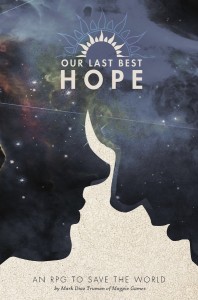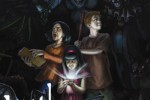Our Last Best Hope
Our Last Best Hope is a complete role-playing game published by Magpie Games.
By Mark Diaz Truman

Welcome to the forty-second Designer’s Diary, a column where designers are given the opportunity to take readers on an in-depth ride through the design and development process of their system, setting, or product. If you’d like to share your product in the Designer’s Diary column, send a message to aaron@roleplayerschronicle.com.
Purchase Our Last Best Hope here
Designer’s Description
Our Last Best Hope is a tabletop roleplaying game for three (3) to five (5) players that takes about two hours to play. During the game, players go through a classic disaster movie, like Sunshine, Deep Impact, The Core, or Armageddon, where your characters are the stars. Each game is unique, as your group confronts a new Crisis with a new set of characters and a new plan to save the Earth.
While playing Our Last Best Hope, you might:
…launch into space to stop a meteor from destroying all life on Earth.
…drill to the center of the Earth to restart its molten core.
…navigate zombie-filled cities to stop a nuclear holocaust.
Our Last Best Hope does not require a GM, nor is there any preptime required before the game starts.

Purpose
I had been playing a lot of one-shot games like Fiasco in the weeks leading up to Game Chef 2012. Players really liked being able to get a game up and running quickly, and it was neat to see a whole story play out in just a few hours. I felt like the Story Game community should invest some effort into creating more games that were accessible, quick, and fun, and I thought I could really add something neat to the genre by writing one of those games.
Influences
Obviously, Fiasco is a huge influence on the game. Jason Morningstar is this amazing, visionary creator, and he really made Our Last Best Hope possible by pioneering the GMless game. Another big influence is Danger Patrol, a John Harper game that’s been floating around the scene for a few years in Beta form. It’s got a ton of neat mechanics that really inspired the Threat mechanics (i.e. main source of conflict) in Our Last Best Hope.

Research
Since OLBH has a huge emphasis on making stuff up and not worrying about the specifics of the science, I didn’t do a lot of research. I did, however, watch Sunshine, Armageddon, and pieces of Deep Impact and The Core.
Art Direction
All of the art pieces in the book are silhouettes done by Marissa Kelly, co-founder of Magpie Games. We think they add a lot of gravitas to the book, and each piece is designed to convey the epic feel of the saving Humanity.

Gaming Experience
I designed OLBH to give players the epic feeling they can usually only get at the end of a long, awesome campaign. I wanted that final battle, the one against the dragon that will destroy the world or the evil mastermind who will enslave humanity, to be a single game session of condensed awesome.
Development Process
I wrote the first draft of Our Last Best Hope for Game Chef in April of 2012. I had a crazy schedule the week of the competition, so I ended up doodling a bunch of notes and ideas for six days and then wrote the whole first draft in one sitting on Sunday evening. I didn’t even get a chance to playtest it!
Marissa really liked the first draft, and pushed me to start thinking about Kickstarting it. We had just finished The Play’s The Thing, our previous Kickstarter project, so I knew we had a following that we could pitch the game to if I thought the game would work. I was skeptical that the draft I had was workable, though, and told Marissa that I would do some playtesting first.
The first playtest was a disaster. If you look at that early version of the game, it’s messy and too open-ended. It wasn’t clear what the game was supposed to do. But the reaction from the players was really positive. People loved the idea of coming up with Crises and Threats and saving humanity from extinction. The energy was totally there!
We ended up Kickstarting the game while I went into overdrive on playtesting. For a few weeks I was running 2-3 playtests a day, improving sections of the game and trying new things. By the time we went to Origins in June, the Kickstarter was up and running, I was making the final improvements to the game, and the process was nearly finished.



